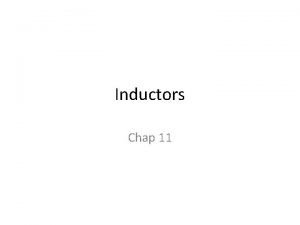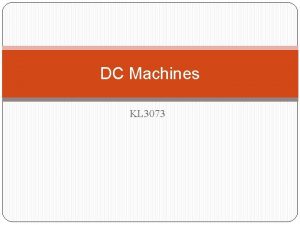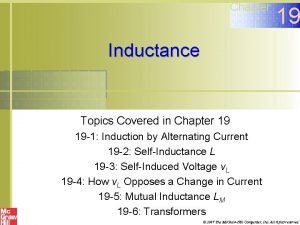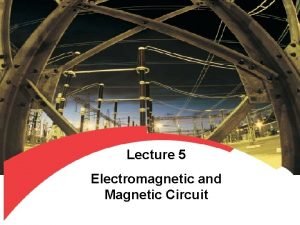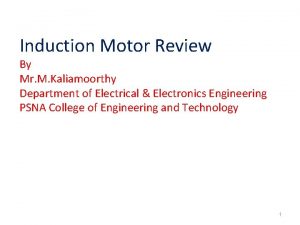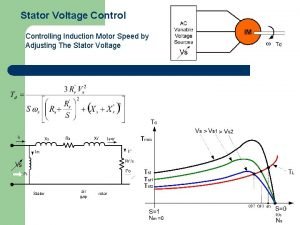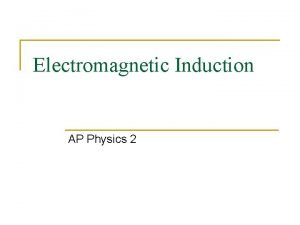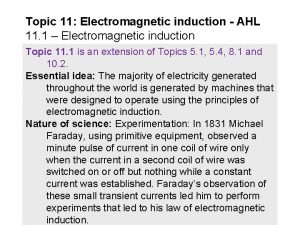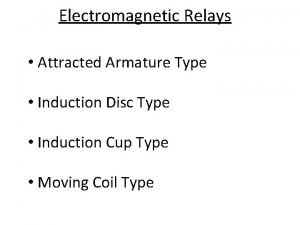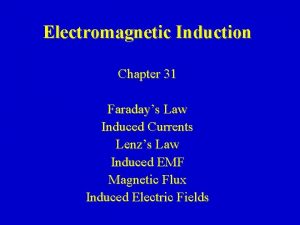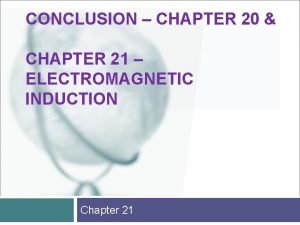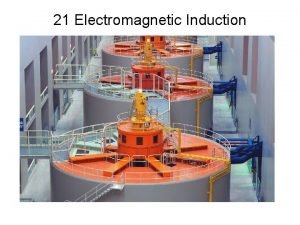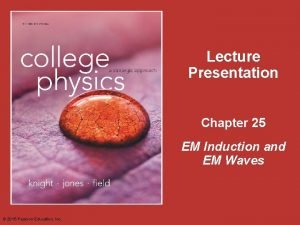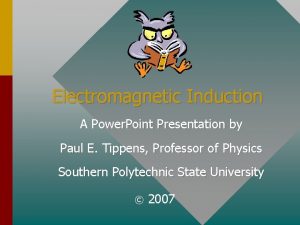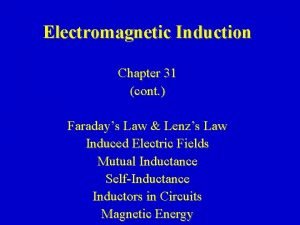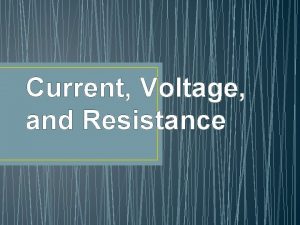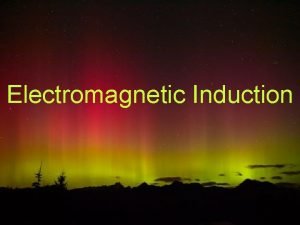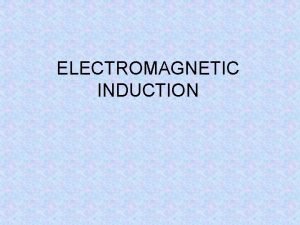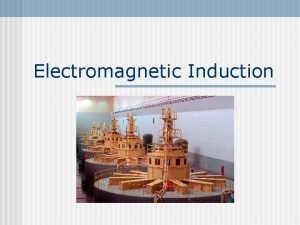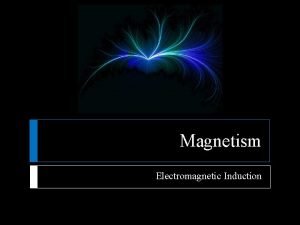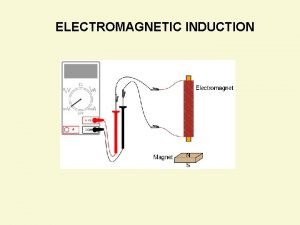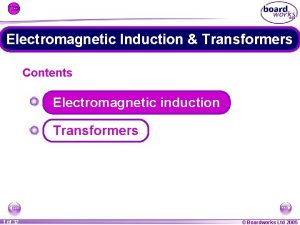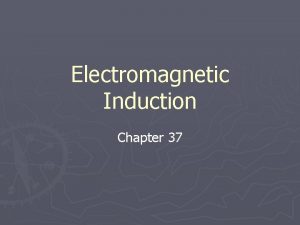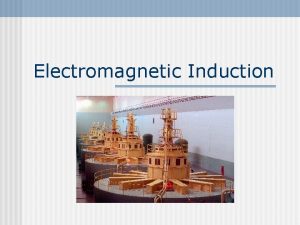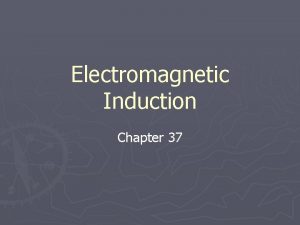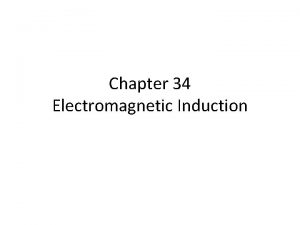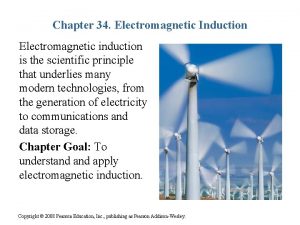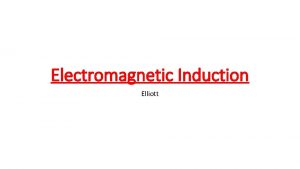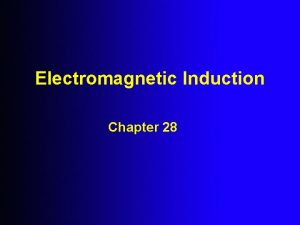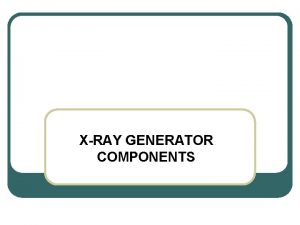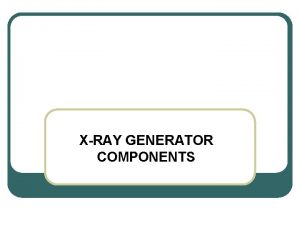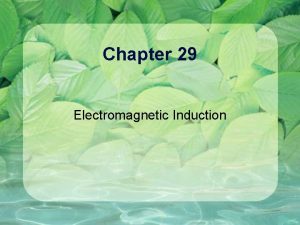Electromagnetic Induction Electromagnetic Induction A voltage is induced




















- Slides: 20

Electromagnetic Induction

Electromagnetic Induction • A voltage is induced when there is relative motion (perpendicular) between a conductor and a magnetic field. • It doesn’t matter which one is moving! • If the conductor completes a circuit, then the induced voltage produces current in the circuit.

Electromagnetic induction is the production of voltage across a conductor moving through a magnetic field.

Demo: Magnet Induces Current Voltage is induced when a magnet moves towards or away from a coil, inducing a current in the coil. Faster the magnet’s motion, the greater the induced current.

Magnetic Flux is the amount of magnetic field that pass through a loop. The curved lines of the field represent so-called lines of magnetic flux, . . .

Faraday’s Law The induced voltage in a coil is proportional to the product of the number of loops and rate at which the magnetic field changes within the loops.

Faraday’s Law: The induced voltage is directly proportional to the number of loops and the rate at which the magnetic flux changes. V = - N ( / t ) V = voltage N = number of turns = change in magnetic flux T = change in time

Applications of Induction Generators • A generator has a coil of wire (rotor) that is rotated in magnetic field (stator). • It’s the exact opposite of a motor, in fact every motor is a generator and vice versa • Demo: Genecon

In a generator: Mechanical energy is converted to electrical energy

In a motor: Electrical energy is converted to mechanical energy

Transformers ALTERNATING Current in a coil creates a changing magnetic field in a nearby coil. Changing the current in the primary coil changes the magnetic flux that is developed. The changing magnetic flux induces a voltage in the secondary coil. The rule is: Power in = Power out. (I*V)in = (I*V)out I* I * V → I* V V→ I* V step up transformer step down transformer

Step up transformers are used in: * power transmission lines Voltages at a Power Plant are stepped up to 100, 000 Volts or more and the power is sent long distances. Since Voltage goes up, Current goes down and heat loss is minimized (Conservation of energy) ballasts for fluorescent light tubes and neon lights *

Step down transformers are used in: * many household appliances such as phone chargers, computers, printers, TV’s laptops, etc. . These devices need only 5 -12 V to operate. * Line Voltages are stepped down to 15, 000 Volts at local substations (Peabody & Vanden). Then it is stepped down to 240 Volts in your neighborhood and goes to the homes and businesses.

More Applications of Induction • Tape Players, Credit cards and Pick-up Coils • A moving magnetic “media” changes the flux through a “playback” head (coil). The alternation of the magnetic field produces an alternating current corresponding to the frequency of music, video or other information.

Self-Inductance When a current is induced by a changing magnetic field, that current itself produces its Primary Magnetic Field own magnetic field. This effect is called self-induction. And it produces a very high voltage: Automobile Ignition Coil Unplugging a working Self-Induced appliance Magnetic Field

Lenz’s Law • Induced current produces a secondary magnetic field that is always opposed to the primary magnetic field that induced it, an effect called Lenz’s law. • Demo: Magnet dropped in a Copper Pipe • Applications • Electromagnetic propulsion and braking • Drop Zone at PGA • Inductive heating

Demo: Lenz’s Law Metal ring is levitated by self-induced secondary magnetic field Connect to alternating current (AC) Oscillating Magnetic Field

Demo: Magnetic Brakes Strong magnet dropped into a copper pipe falls slowly due to secondary magnetic field induced by its motion.

Great America’s Drop Zone has a 22 story freefall, lasting four seconds, decelerated by magnetic braking.

Field Induction • Maxwell’s Laws of Field Induction • A changing magnetic field produces a changing electric field. • A changing electric field produces a changing magnetic field. • Circuit Resonance, EM Waves, and Nikola Tesla
 London forces
London forces Induced voltage formula
Induced voltage formula Induced voltage formula
Induced voltage formula Induced voltage formula
Induced voltage formula Application of magnetic circuit
Application of magnetic circuit Peak to peak voltage formula
Peak to peak voltage formula Low voltage vs medium voltage
Low voltage vs medium voltage What is the objective of earthing
What is the objective of earthing Control of induction motor by ac voltage controllers
Control of induction motor by ac voltage controllers Line current and phase current
Line current and phase current Induced torque
Induced torque Stator voltage control of 3 phase induction motor
Stator voltage control of 3 phase induction motor Electromagnetic induction microphone
Electromagnetic induction microphone Electromagnetic induction
Electromagnetic induction Induction disc
Induction disc Faraday principle
Faraday principle Conclusion of electromagnetic induction
Conclusion of electromagnetic induction Motional emf units
Motional emf units Faraday's law of electromagnetic induction ppt
Faraday's law of electromagnetic induction ppt Electromagnetic induction ppt
Electromagnetic induction ppt Faraday's law of electromagnetic induction
Faraday's law of electromagnetic induction

